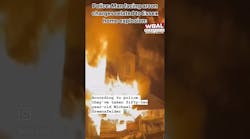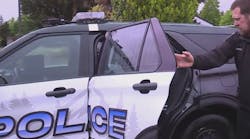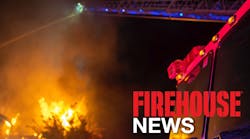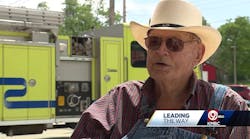On Wednesday, Aug. 10, 2011, a three-alarm fire destroyed the former Rieter Automotive Systems Group plant in Lowell, IN. Due to the advanced stage of the fire on arrival, no interior operations were initiated. Even though five municipal hydrants were in use, water supply became an issue several hours into the incident, so a drafting operation was set up using a nearby creek.
The vacant plant, which was being demolished at the time of the fire, consisted of a 110,000-square-foot manufacturing area built of Type II and Type III construction and a 110,000-square-foot warehouse built of Type II construction. The roof was made of a partial metal/partial flat-rubber/aggregate material and partial bow-string truss. All fire detection and protection systems were shut off when the plant closed in November 2010. The facility had produced acoustic and automotive-trim products for vehicle and appliance manufacturers.
The Lowell Fire Department was dispatched to a reported structure fire at the Rieter plant at 101 West Oakley Ave. at 11:45 A.M. Engines 6611 and 6615, Quint 6621, a 75-foot aerial ladder, and Squad 6651 responded with seven firefighters under the command of Assistant Fire Chief Charlie Scott. The Lake Dalecarlia Volunteer Fire Department responded with Engine 5811 and three personnel on automatic mutual aid and Tri-Creek Emergency Medical Services responded with an ambulance for standby.
Initial operations
Squad 6651 was first to arrive. Scott found heavy smoke coming from a large portion of the manufacturing area roof and fire showing on side D (west) of the structure from open overhead doors. The contractor working on the demolition had evacuated 12 workers from the plant and advised Scott that all workers were accounted for.
Lowell Engine 6611 laid an 800-foot, five-inch line from the nearest working hydrant located directly north of the fire scene on Harding Drive to side A. Lowell Aerial 6621 were positioned on side A and supplied with a 100-foot, five-inch line from Engine 6611. Engine 6611 placed its deck gun into operation and Aerial 6621 was set up for aerial master stream operations. Lake Dalecarlia Engine 5811 was assigned to the A/D corner. Lowell Engine 6615 laid a 650-foot, five-inch line from a hydrant on Oakley Avenue west of the scene to supply Lake Dalecarlia Engine 5811, which placed its deck gun into operation. Engine 6615 was staged and its crew was assigned to assist with master stream deployment.
Scott requested a box alarm at 11:48 A.M. St. John Fire Department Truck 7521, a 100-foot tower ladder, Hebron Volunteer Fire Department Engine 1712 and a chief’s vehicle and Crown Point Fire Rescue Engine 1515, Truck 1521, a 100-foot tower ladder, one ambulance and a chief’s vehicle responded with 28 firefighters. St. John Truck 7521 was positioned at the A/B corner and set up for elevated master stream operations. Hebron Engine 1712 laid a 450-foot, five-inch line from a hydrant to the east on Oakley Avenue to supply St. John Truck 7521.
Additional alarms
Scott requested second and third box alarms at 11:56 A.M. Second-alarm responding units included Schererville Fire Department Quint 8022, a 75-foot aerial ladder, Shelby Volunteer Fire Department Engine 21-A, Schneider Volunteer Fire Department Engine 8210 and Lake Township Volunteer Fire Department Engine 402. Lake County HazMat responded with two command vehicles and two light plants. Schererville 8022 was placed on side A between Lowell Engine 6611 and Lake Dalecarlia Engine 5811 and set up for elevated master stream operations, supplied by Lake Dalecarlia Engine 5811.
Schneider Engine 8210 and Lake Township Engine 402 laid a five-inch line from the north at Route 2 and Harding Drive to the scene. This proved to be 500 feet short because both Schneider and Lake Township serve rural areas with no hydrants and therefore do not carry large amounts of five-inch hose. Crown Point Engine 1515 finished the 1,080-foot, five-inch line from the north at Route 2 and Harding Drive that Schneider and Lake Township started to supply Beecher Truck 405. Crown Point Engine 1515 was positioned at that hydrant on Route 2 and Harding Drive to pump to Beecher Truck 405
Lake County HazMat Chief Ron Svetic was assigned as the staging officer. Lake County HazMat Captain Nick Dvorsak was assigned to the C/D side along with Crown Point Fire Chief Greg DeLor, who provided reports to command regarding fire conditions in those sectors before apparatus could access them. Lake Township Engine 402 was assigned to the hydrant on West Oakley Avenue to pump to Lake Dalecarlia Engine 5811. Schneider Engine 8210 was assigned to the hydrant on East Oakley Avenue to pump to Hebron Engine 1712. Shelby Engine 21-A was placed in Level 1 staging with its personnel assigned to assist Hebron and St. John crews with setup and suppression efforts on the A/B corner.
Responding on the third alarm were Hobart Fire Department Engine 5614, Beecher Fire Department Quint 405, a 75-foot aerial ladder, Lake Hills Volunteer Fire Department Engine 5912, Union Township Volunteer Fire Department Engine 1121, Dyer Volunteer Fire Department Truck 1821, a 100-foot tower ladder, Porter Township Volunteer Fire Department Engine 1310 and Cedar Lake Volunteer Fire Department Engine 1212. Hobart Engine 5614 was assigned to cover the Lowell Fire Department’s station. Beecher Truck 405 was assigned to side A next to Lowell Truck 6621 and placed its elevated master stream into operation. Dyer Truck 1821 was assigned to staging and was on standby for any further calls in Lowell’s service area. They were released from staging at 8 P.M. without operating at the scene.
Union Township Truck 1121 was assigned to relieve Hobart Engine 5614 at Lowell’s station for standby. Porter Township Engine 1310 and Fire Chief were assigned to relieve Union Township Engine 1121 to standby at Lowell’s station to cover any further calls in the Lowell and Lake Dalecarlia service area. Porter Township Engine 1310 was eventually requested at the scene to assist with cleanup of the hundreds of feet of five-inch line.
Once becoming available from the funeral of one of its firefighters, Cedar Lake Engine 1212 arrived on scene and was assigned to relay pump from the hydrant on Harding Drive 800 feet from Lowell Truck 6621. Crown Point Truck 1521 arrived at 3:30 P.M., when it became available after having maintenance performed. This apparatus was placed in staging due to lack of adequate water supply to use this apparatus and was released at 7 P.M.
Drafting operations
At 3:30 P.M., a drafting operation was set up using a nearby creek for an alternative water supply. This operation supplied a Lake Dalecarlia relay pumper at the fire scene using 743 feet of five-inch line. This engine then supplied Schererville Quint 8022 using an additional 625 feet of five-inch line.
Lake Hills Engine 5912 was the initial apparatus sent to set up drafting operations at a creek 500 feet east of the fire scene. After several unsuccessful attempts by Lake Hills Engine 5912 to draft, Shelby Engine 21-A was assigned this task. That engine briefly drafted from the creek, but after having to shut down for a short period to move supply lines, it burnt out its primer pump. Lowell Engine 6615 was then sent to the creek to set up for the draft operation and supplied Schererville Truck 8022 once it moved to side C to operate its elevated master stream.
After being informed by Lowell Public Works Director Greg Shook at 4 P.M. that the west-side water tower’s water supply was almost completely diminished, water-supply operations were set up from hydrants fed from the east-side water tower. Lowell Engine 6611 was assigned to a hydrant in the south municipal parking lot behind the old downtown section of Lowell 1,100 feet from the fire scene. Lake Township Support 405 and personnel were assigned to move five-inch lines from the West Oakley Avenue and Route 2 and Harding Drive hydrants to the new hydrant in the south municipal parking lot. This five-inch line was laid across a creek and through the American Legion grounds south to the fire scene. Lake Township Engine 402 was placed midline in the lay to relay pump to Beecher Truck 405 operating on side A.
At 4 P.M., Schererville Truck 8022 and Lowell Truck 6621 were moved to side C to operate elevated master streams to areas inaccessible from side A. These two apparatus were supplied with 600 feet of five-inch line fed by the drafting operation at the creek. Lake Dalecarlia Engine 5811 was placed midline on side A from the drafting operation to relay pump to these apparatus. Lowell Truck 6621 laid 100 feet of five-inch line to Schererville Truck 8022 during this operation. This was not adequate to supply both trucks simultaneously; therefore, only one apparatus could operate at a time, depending on where hot spots were encountered. Schererville Truck 8022 also supplied a high-rise lay of 200 feet of 1¾-inch hose to a team of firefighters that ascended the east (and taller of the two) storage tower on the fourth and fifth stories. This team consisting of firefighters from Schererville and Lowell was led in this interior operation by Crown Point Fire Chief Greg DeLor. This operation was undertaken due to a moderate amount of burning material on the fourth and fifth stories of this storage tower which was inaccessible using elevated master streams. This short, but strenuous operation extinguished the fire in the east storage tower.
Lowell Rescue 6631 responded at 5 P.M. to bring personnel to the scene and ultimately provide scene lighting. Tender 6642, a 3,000-gallon tanker, and Tender 6641, a 3,000-gallon tanker, also responded at this time to provide additional five-inch large hose as well as to supply Lake Dalecarlia 5811 during interior operations on the western storage tower.
Under control
Lowell Fire Chief Clint Gorball declared the fire under control at 6 P.M. Two large excavators were then acquired for use from Hardings Inc., a company across the street from the fire scene that services, rents and sells heavy equipment. WEL companies provided one equipment operator and Lake Dalecarlia Fire Chief Ryan Kennedy, who is a heavy-equipment operator by trade, began demolition operations with the excavators. This allowed better access to hot spots once parts of the building were moved.
At 8 P.M., the fire in the interior portion of the west storage tower remained a concern after several attempts to extinguish it using elevated master streams were unsuccessful. A team of firefighters from Lake Dale, Hebron, and Lowell led by Lowell Fire Chief Clint Gorball in an interior operation on the west storage tower. Lake Dalecarlia Engine 5811 was supplied by Lowell Tenders 6642 and 6641 provided two, 200-foot, 1¾-inch handlines for this operation on side D.
Firefighters scaled a ladder attached to the building to access a catwalk over the roof of the structure to a man door on the storage tower. This ladder and catwalk were sounded for stability prior going ahead with the operation. An attack team with one 1¾-inch hoseline was sent across the catwalk to the man door and a backup team with the second, 1¾-inch hoseline was placed on the catwalk just above the ladder. When firefighters reached the unsecured man door on the storage tower, heavy fire was found just inside. The fire was quickly knocked down by the first attack team, who stated it appeared insulation that had dropped from the upper floors of the storage tower was burning.
After initial knockdown of the fire was achieved, the first attack team switched with the backup team to finish mop-up operations. The second attack team was equipped with a foam nozzle attached to the 1¾-inch line to suppress any additional fire encountered with the second attack. This operation was successful in extinguishing the interior fire in the west storage tower using less than 1,000 gallons of water.
Conclusion
Mutual aid departments began being released at 8 P.M., with the last units released at 4 A.M. on Aug. 11. Lowell apparatus left the scene at 4:56 A.M.
The weather was sunny with a temperature of 80 degrees. There were no civilian or firefighter injuries. It was determined that contractors using a torch for cutting operations in the center of the manufacturing area to remove beams so that machinery could be removed from the building was responsible for the fire. Damage was estimated at $3 million to the building and $393,000 to the contents.






